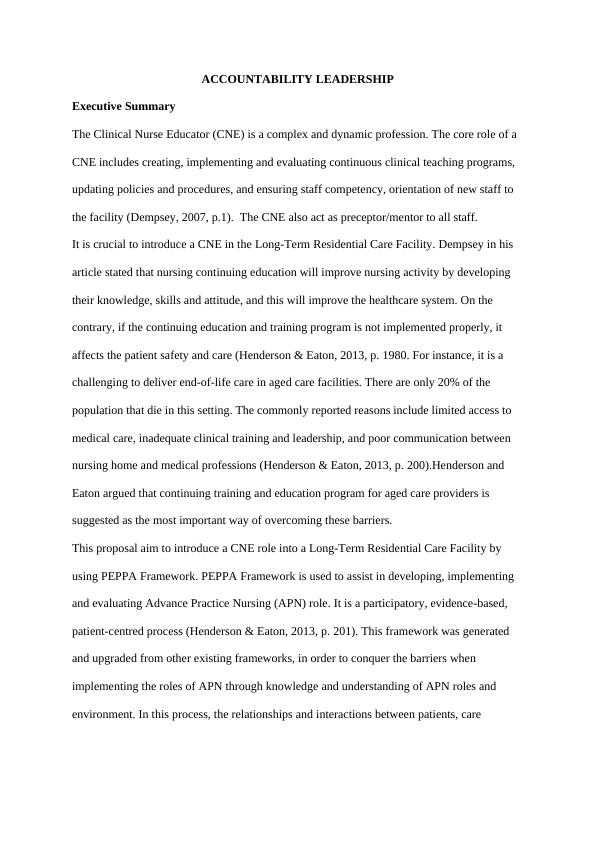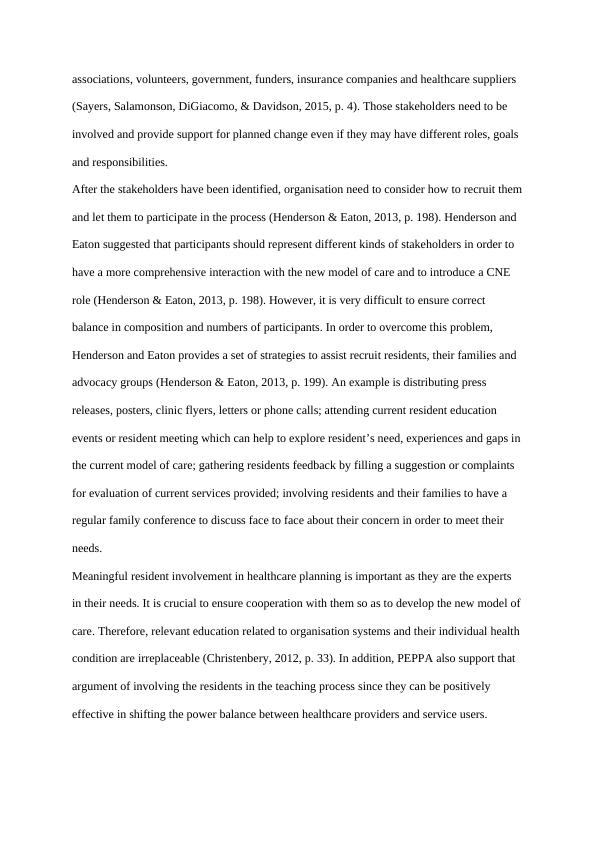Introducing a Clinical Nurse Educator (CNE) Role in Long-Term Residential Care Facility: A PEPPA Framework Proposal
Added on 2023-06-04
14 Pages4056 Words438 Views
ACCOUNTABILITY LEADERSHIP
NAME:
INSTITUTION:
TUTOR:
DATE:
NAME:
INSTITUTION:
TUTOR:
DATE:

ACCOUNTABILITY LEADERSHIP
Executive Summary
The Clinical Nurse Educator (CNE) is a complex and dynamic profession. The core role of a
CNE includes creating, implementing and evaluating continuous clinical teaching programs,
updating policies and procedures, and ensuring staff competency, orientation of new staff to
the facility (Dempsey, 2007, p.1). The CNE also act as preceptor/mentor to all staff.
It is crucial to introduce a CNE in the Long-Term Residential Care Facility. Dempsey in his
article stated that nursing continuing education will improve nursing activity by developing
their knowledge, skills and attitude, and this will improve the healthcare system. On the
contrary, if the continuing education and training program is not implemented properly, it
affects the patient safety and care (Henderson & Eaton, 2013, p. 1980. For instance, it is a
challenging to deliver end-of-life care in aged care facilities. There are only 20% of the
population that die in this setting. The commonly reported reasons include limited access to
medical care, inadequate clinical training and leadership, and poor communication between
nursing home and medical professions (Henderson & Eaton, 2013, p. 200).Henderson and
Eaton argued that continuing training and education program for aged care providers is
suggested as the most important way of overcoming these barriers.
This proposal aim to introduce a CNE role into a Long-Term Residential Care Facility by
using PEPPA Framework. PEPPA Framework is used to assist in developing, implementing
and evaluating Advance Practice Nursing (APN) role. It is a participatory, evidence-based,
patient-centred process (Henderson & Eaton, 2013, p. 201). This framework was generated
and upgraded from other existing frameworks, in order to conquer the barriers when
implementing the roles of APN through knowledge and understanding of APN roles and
environment. In this process, the relationships and interactions between patients, care
Executive Summary
The Clinical Nurse Educator (CNE) is a complex and dynamic profession. The core role of a
CNE includes creating, implementing and evaluating continuous clinical teaching programs,
updating policies and procedures, and ensuring staff competency, orientation of new staff to
the facility (Dempsey, 2007, p.1). The CNE also act as preceptor/mentor to all staff.
It is crucial to introduce a CNE in the Long-Term Residential Care Facility. Dempsey in his
article stated that nursing continuing education will improve nursing activity by developing
their knowledge, skills and attitude, and this will improve the healthcare system. On the
contrary, if the continuing education and training program is not implemented properly, it
affects the patient safety and care (Henderson & Eaton, 2013, p. 1980. For instance, it is a
challenging to deliver end-of-life care in aged care facilities. There are only 20% of the
population that die in this setting. The commonly reported reasons include limited access to
medical care, inadequate clinical training and leadership, and poor communication between
nursing home and medical professions (Henderson & Eaton, 2013, p. 200).Henderson and
Eaton argued that continuing training and education program for aged care providers is
suggested as the most important way of overcoming these barriers.
This proposal aim to introduce a CNE role into a Long-Term Residential Care Facility by
using PEPPA Framework. PEPPA Framework is used to assist in developing, implementing
and evaluating Advance Practice Nursing (APN) role. It is a participatory, evidence-based,
patient-centred process (Henderson & Eaton, 2013, p. 201). This framework was generated
and upgraded from other existing frameworks, in order to conquer the barriers when
implementing the roles of APN through knowledge and understanding of APN roles and
environment. In this process, the relationships and interactions between patients, care

workers, organisations and other stakeholders have been emphasised. It is a complex and
dynamic process to introduce an advanced nursing role into a workplace.
Step 1: Define patient population and describe current model of care
The identified priority patient population in this proposal should be ageing population, as
Mohamed in his article stated that the world’s population is ageing (Mohamed, 2016, p. 1).
There are an increasing number of elder people who live and die in an Aged Care Facilities.
In order to provide best care for elderly, staff needs to gain updated education from an
expertise.
Model of Care means the way health services are delivered. It is a multifaceted concept, it
outlines the best practice care and services delivered to a patient or patient cohort through the
application of a set of services and principles. It aims to ensure patient get the right care, at
the right time, by the right team and in the right place (Oermann, 2016, p. 2).
The current model of care in the Aged Care Facilities the writer worked in, is the Resident
(patient)-centred care but lack of evidence hampered research to some extent. The care
provider generated a specific care plan according to each individual client Such as what the
Registered Nurse did with the client, their family, Local Medical Officer (LMO), and other
health professional (e.g. Physiotherapist, podiatrist, etc.). When considering to introduce a
CNE role into the facility, the benefit should not be limited to the clients alone as they can get
best care from well trained staff. The benefits should also be extended to protect care
providers by continuous training to avoid unaware of updated regulations and standards.
Step 2: Identify stakeholders and recruit participants
The stakeholders can be divided into internal and external to the organisation (PEPPA). The
internal stakeholders include residents and families, nurses, Advanced nurses, managers,
physicians and other healthcare providers, etc. The external stakeholders include professional
dynamic process to introduce an advanced nursing role into a workplace.
Step 1: Define patient population and describe current model of care
The identified priority patient population in this proposal should be ageing population, as
Mohamed in his article stated that the world’s population is ageing (Mohamed, 2016, p. 1).
There are an increasing number of elder people who live and die in an Aged Care Facilities.
In order to provide best care for elderly, staff needs to gain updated education from an
expertise.
Model of Care means the way health services are delivered. It is a multifaceted concept, it
outlines the best practice care and services delivered to a patient or patient cohort through the
application of a set of services and principles. It aims to ensure patient get the right care, at
the right time, by the right team and in the right place (Oermann, 2016, p. 2).
The current model of care in the Aged Care Facilities the writer worked in, is the Resident
(patient)-centred care but lack of evidence hampered research to some extent. The care
provider generated a specific care plan according to each individual client Such as what the
Registered Nurse did with the client, their family, Local Medical Officer (LMO), and other
health professional (e.g. Physiotherapist, podiatrist, etc.). When considering to introduce a
CNE role into the facility, the benefit should not be limited to the clients alone as they can get
best care from well trained staff. The benefits should also be extended to protect care
providers by continuous training to avoid unaware of updated regulations and standards.
Step 2: Identify stakeholders and recruit participants
The stakeholders can be divided into internal and external to the organisation (PEPPA). The
internal stakeholders include residents and families, nurses, Advanced nurses, managers,
physicians and other healthcare providers, etc. The external stakeholders include professional

associations, volunteers, government, funders, insurance companies and healthcare suppliers
(Sayers, Salamonson, DiGiacomo, & Davidson, 2015, p. 4). Those stakeholders need to be
involved and provide support for planned change even if they may have different roles, goals
and responsibilities.
After the stakeholders have been identified, organisation need to consider how to recruit them
and let them to participate in the process (Henderson & Eaton, 2013, p. 198). Henderson and
Eaton suggested that participants should represent different kinds of stakeholders in order to
have a more comprehensive interaction with the new model of care and to introduce a CNE
role (Henderson & Eaton, 2013, p. 198). However, it is very difficult to ensure correct
balance in composition and numbers of participants. In order to overcome this problem,
Henderson and Eaton provides a set of strategies to assist recruit residents, their families and
advocacy groups (Henderson & Eaton, 2013, p. 199). An example is distributing press
releases, posters, clinic flyers, letters or phone calls; attending current resident education
events or resident meeting which can help to explore resident’s need, experiences and gaps in
the current model of care; gathering residents feedback by filling a suggestion or complaints
for evaluation of current services provided; involving residents and their families to have a
regular family conference to discuss face to face about their concern in order to meet their
needs.
Meaningful resident involvement in healthcare planning is important as they are the experts
in their needs. It is crucial to ensure cooperation with them so as to develop the new model of
care. Therefore, relevant education related to organisation systems and their individual health
condition are irreplaceable (Christenbery, 2012, p. 33). In addition, PEPPA also support that
argument of involving the residents in the teaching process since they can be positively
effective in shifting the power balance between healthcare providers and service users.
(Sayers, Salamonson, DiGiacomo, & Davidson, 2015, p. 4). Those stakeholders need to be
involved and provide support for planned change even if they may have different roles, goals
and responsibilities.
After the stakeholders have been identified, organisation need to consider how to recruit them
and let them to participate in the process (Henderson & Eaton, 2013, p. 198). Henderson and
Eaton suggested that participants should represent different kinds of stakeholders in order to
have a more comprehensive interaction with the new model of care and to introduce a CNE
role (Henderson & Eaton, 2013, p. 198). However, it is very difficult to ensure correct
balance in composition and numbers of participants. In order to overcome this problem,
Henderson and Eaton provides a set of strategies to assist recruit residents, their families and
advocacy groups (Henderson & Eaton, 2013, p. 199). An example is distributing press
releases, posters, clinic flyers, letters or phone calls; attending current resident education
events or resident meeting which can help to explore resident’s need, experiences and gaps in
the current model of care; gathering residents feedback by filling a suggestion or complaints
for evaluation of current services provided; involving residents and their families to have a
regular family conference to discuss face to face about their concern in order to meet their
needs.
Meaningful resident involvement in healthcare planning is important as they are the experts
in their needs. It is crucial to ensure cooperation with them so as to develop the new model of
care. Therefore, relevant education related to organisation systems and their individual health
condition are irreplaceable (Christenbery, 2012, p. 33). In addition, PEPPA also support that
argument of involving the residents in the teaching process since they can be positively
effective in shifting the power balance between healthcare providers and service users.

End of preview
Want to access all the pages? Upload your documents or become a member.
Related Documents
A Systematic Review of Interventions to Change Staff Care Practices in Order to Improve Resident Outcomes in Nursing Homeslg...
|13
|3195
|104
Essay | Nursing Shortagelg...
|4
|1365
|161
How to write an annotated bibliography || Documentlg...
|12
|3000
|17
Empowering Patients Experiencing Alcohol Addictionlg...
|4
|562
|53
